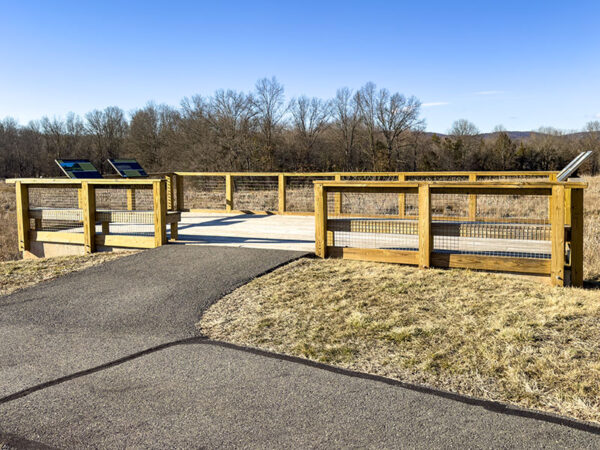Description
Named after the revered naturalist and author, Aldo Leopold, Leopold’s Preserve is a 380-acre nature preserve and urban oasis containing diverse habitats and a rich history. Its 7 miles of natural surface trails traverse wetlands, wildflower meadows, and hardwood forests, providing opportunities to spot a wide variety of birds and other wildlife, including turtles, frogs, deer, muskrat, beaver, butterflies, and dragonflies. Interpretive signs describing the preserve’s natural and historical features can be found throughout its trails. Formerly a farmland, the property continues to be actively restored to native habitats by the White House Farm Foundation and is permanently protected through a conservation easement held by the Northern Virginia Conservation Trust.
A popular location for local birders, over 200 bird species have been documented at Leopold’s Preserve. Wood duck, eastern bluebird, red-shouldered hawk, and red-winged blackbird can be found year-round. From spring through summer, look for green heron, great egret, yellow-billed cuckoo, eastern kingbird, orchard oriole, prairie warbler, and indigo bunting. Lucky visitors may also spot migrating warblers in spring and fall, a diversity of waterfowl in the winter, and the occasional trumpeter swan, American woodcock, Wilson’s snipe, or American bittern in spring.

The observation deck overlooking the wetlands has been retrofitted with cables to give seated visitors a better view of waterfowl and wading birds. Photo Credit: Lisa Mease/DWR
The 0.65-mile Wood Duck Way loop trail is particularly recommended for birders, as it provides views of the preserve’s extensive wetlands and features a large observation platform as well as nest boxes for eastern bluebird and wood duck. A paved path from the parking area provides easy access to the platform. Birders will also enjoy the .25-mile Meadow Loop trail, which travels through a brushy restored meadow, full of native wildflowers and sumacs attractive to birds and pollinators. This trail also leads to Berry Pond, a favorite swimming hole during the heydays of Thoroughfare, a thriving Black community established after the American Civil War. About 0.5 miles east of the pond, on the main Leopold’s Loop trail, is another habitat highlight for wildlife viewers–an upland depression swamp. This ephemeral wetland, attractive to birds and amphibians, is best viewed in the spring or after summer rains. For tree enthusiasts, the preserve offers a self-guided native tree ID walk scattered throughout its trails that contain QR codes with information on the trees.
Notes:
- The eastern portion of the preserve surrounds private property. Please be respectful of the boundaries while exploring the area.
- Entrances to the preserve located within the private Villages of Piedmont community are not for public access.
Directions
Physical Address: 16290 Thoroughfare Rd, Broad Run, VA 20137
From Haymarket, travel west on Rt. 55/John Marshall Highway, then turn left onto SR-682/Thoroughfare Road. Continue a short distance as the paved road turns to gravel. Cross the railroad tracks and in just a few hundred yards you will see the parking areas located to the left (Parking Lot East) and right (Parking Lot West).
Location & Directions
View on Google MapsSite Information
- Site Contact: White House Farm Foundation: 571-358-2098, info@whfarmfoundation.org
- Website
- Access: Free, Open daily from dawn to dusk
Birds Recently Seen at Leopold’s Preserve (as reported to eBird)
- Killdeer
- Turkey Vulture
- Bald Eagle
- Red-shouldered Hawk
- Red-headed Woodpecker
- Red-bellied Woodpecker
- Downy Woodpecker
- Hairy Woodpecker
- Pileated Woodpecker
- Northern Flicker
Seasonal Bird Observations
Facilities
- Accessible
- Hiking Trails
- Interpretive Trail
- Parking
- Restrooms
- Observation Platform
- Historical Site

